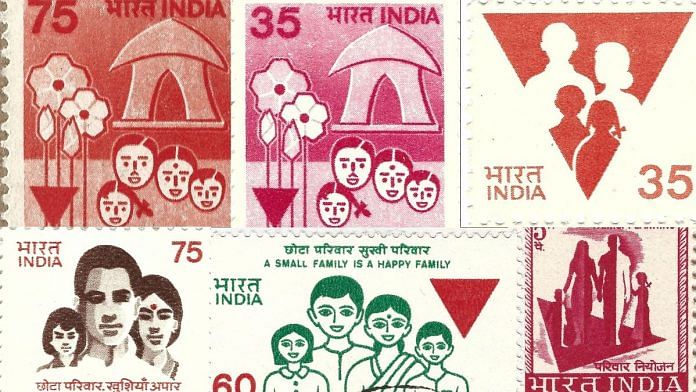India was one of the first countries in the world to introduce a policy for family planning. But the issue did not receive sustained attention from the government until the mid-1960s when the population growing at an increasing rate raised the spectre of persistent food shortages, stunted economic growth and diminished international strategic autonomy. Given the limited reach of television and radio, which covered barely a fourth of the population, the Indian government relied heavily on the Indian Posts and Telegraphs Department (P&T) to spread awareness about the need for population control.
The P&T used commemorative and definitive postage stamps, printed slogans/advertisements on postal stationery and slogan postmarks to communicate the importance and advertise the methods of family planning. In addition, permanent enamelled metal signboards were supposedly placed on the premises of the nearly one lakh post offices across India.
This is the story of how stamps became part of the country’s family planning mission.
Also read: To make babies or not? That’s the dilemma in China as cost of raising kids soars & soars
Plan your family
On 12 December 1966, the Indian Posts and Telegraphs Department issued two-and-a-half million copies of the commemorative postage stamp captioned ‘Plan Your Family: Family Planning Week/ परिवार नियोजन कीजिये: परिवार नियोजन सप्ताह’ (Image 1). The information brochure issued along with the stamp justified the emphasis on family planning considering “population explosion” in a country that “comprises 14% of the world’s population… on 2.4% of the world’s land area.” It added that the government was setting up research and training institutions to facilitate family planning and solicited “[t]he cooperation and active participation of all the people in this National Task.”
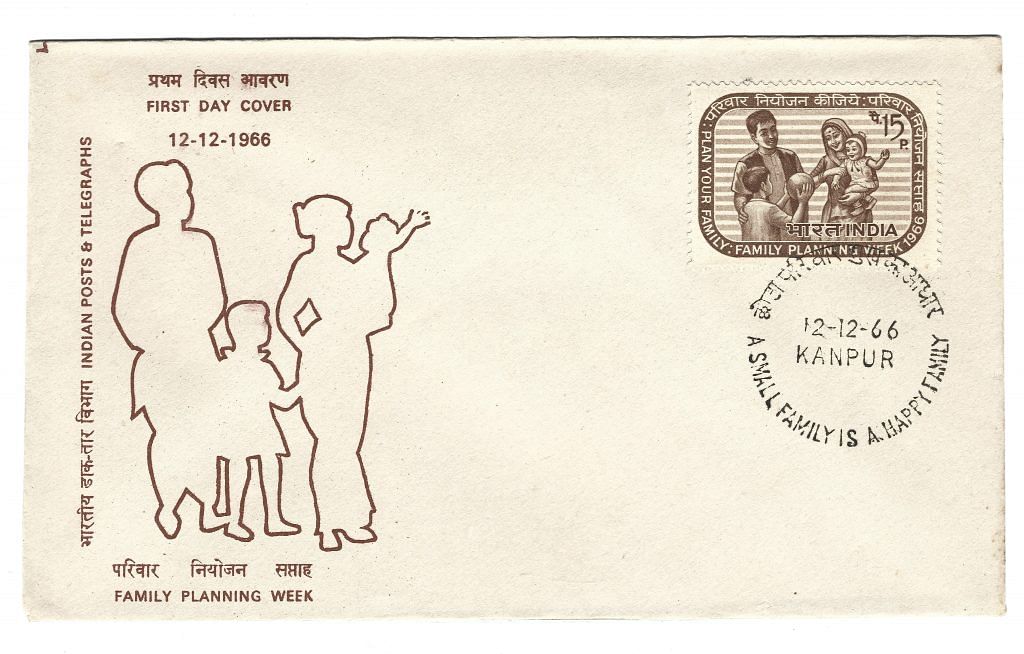
The stamp showed a happy family of four including two children—a boy not yet ten standing next to his father and a less than two-year-old girl in her mother’s arms. The cachet of the First Day Cover (FDC) of this stamp, too, showed a family of four but here the boy is a toddler while the girl is older. Interestingly, the postmark used to cancel the stamp on the first day of issue conveys two different messages in Hindi (‘छोटा परिवार सुख का आधार’, that is, ‘A small family is the foundation of happiness’) and English (‘A small family is a happy family’). So, while the caption of the stamp exhorts people to plan their families, the message in the postmark extols the virtues of a small family. In later family planning messages, ‘Plan Your Family’ is also translated as ‘कम बच्चे सुखी जीवन (Fewer children, happy life)’.
From the first commemorative issue, we learn two things about the government’s approach. First, the ideal was a gender-balanced family of four with adequate spacing between the birth of the children. Second, the government’s initiative was limited to creating awareness, exhorting people to voluntarily limit their family size, and making contraceptives available.
The year 1970 witnessed innovations in the use of postal channels for promoting family planning. The India National Philatelic Exhibition that was held in New Delhi featured family planning as a major theme. In another first, the information brochures of stamps on institutions/organisations began to highlight family planning. The brochure of the commemorative stamp on the golden jubilee of the Indian Red Cross Society (1970) noted that it “lays emphasis on family planning work” and was “running over 300 family planning centres in the country.” Later, commemoratives on the centenary of the Young Women’s Christian Association (1975), the golden jubilee of the Federation of Indian Chambers of Commerce & Industry (1977) and the centenary of the PHD Chamber of Commerce and Industry (2005), too, emphasised their contribution to family planning.
Yet another innovation was introduced in 1975 when the commemorative stamp on Satellite Instructional Television Experiment (Image 2) depicted the family planning triangle alongside symbols of agriculture, health, and education on the stamp. A final innovation was introduced in 1994, when the brochures of commemorative stamps on personalities/companies began to highlight their contribution to population control. The brochure of the JRD Tata stamp emphasised that he “crusaded for causes which he felt were in the national interest such as family planning and population control.” In 1997, the brochure of the stamp on Ram Manohar Lohia suggested that he “had pleaded for… more effective birth control measures.” Similarly, the commemorative issue on the centenary of the Godrej Group (1998) highlighted its contribution to family planning.
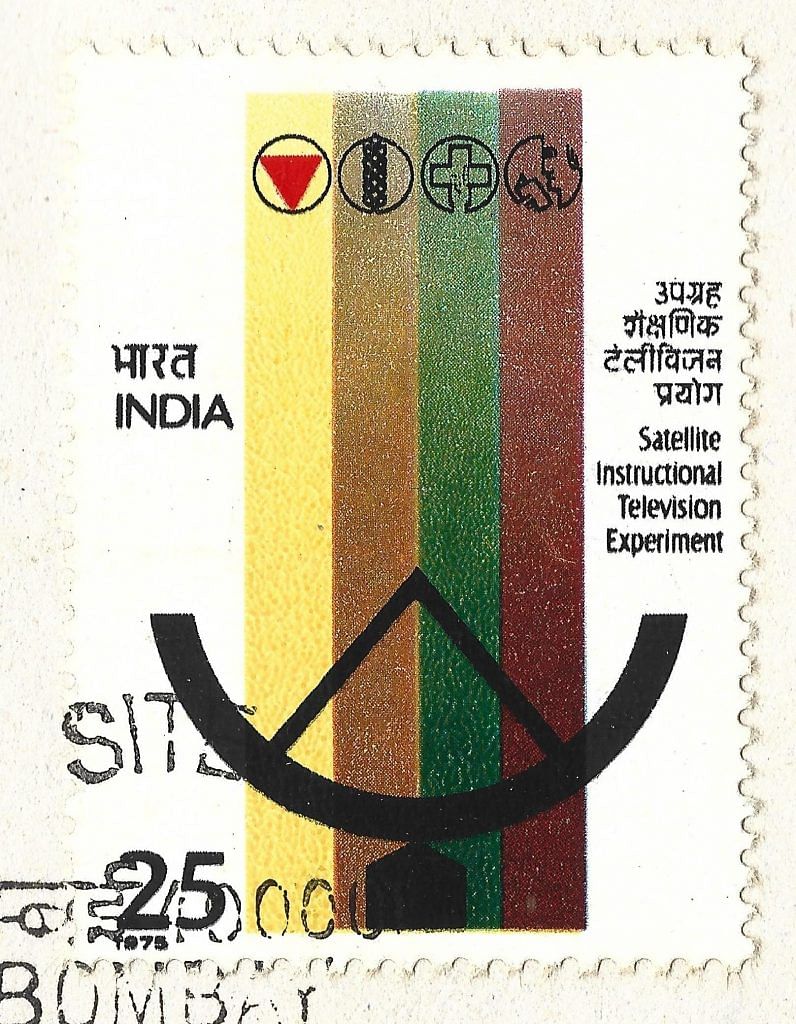
Also read: Indian State was set up to control, not govern. Data-driven policy-making can be antidote
The vermillion triangle
In 1967, P&T released the first definitive stamp on family planning as part of the fourth definitive series. Unlike commemoratives that are printed in limited quantities and not reprinted once the stock is exhausted, definitives are printed in much larger quantities and remain in circulation until a new series is issued.
The first definitive stamp depicts a couple with two children, including a boy and a girl, standing on a triangle denoting family planning (Image 3). This stamp introduced two new elements that became fixed points of the family planning propaganda. First, the girl was shown to be the older sibling. Second, an inverted solid vermillion, equilateral triangle was used as the symbol of family planning. This stamp was the most widely used family planning stamp and was reissued at least four times, including as part of the fifth definitive series.
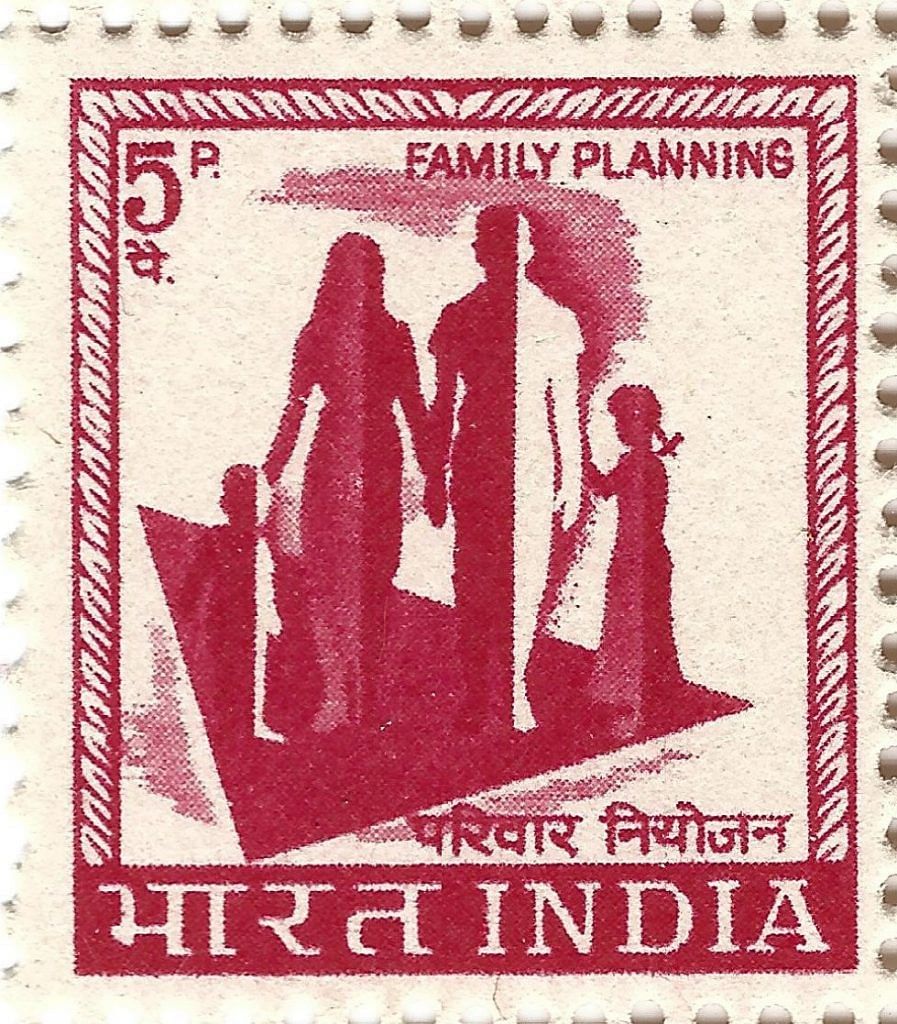
The sixth definitive series included a stamp on family planning that showed a family of four, an inverted triangle, and two flowers and two buds and added a new feature – a house in the background, possibly signifying resource constraint (Image 4). Three stamps on family planning were issued as part of the seventh definitive series including the 1980 stamp with a change in its denomination from 35 to 75 paise (Image 5). The other two included a stamp with a cutout of a family of four within a family planning triangle (Image 6), and another stamp with a sketch of a family of four next to a triangle and the caption ‘A small family is a happy family/छोटा परिवार सुखी परिवार’ (Image 7).
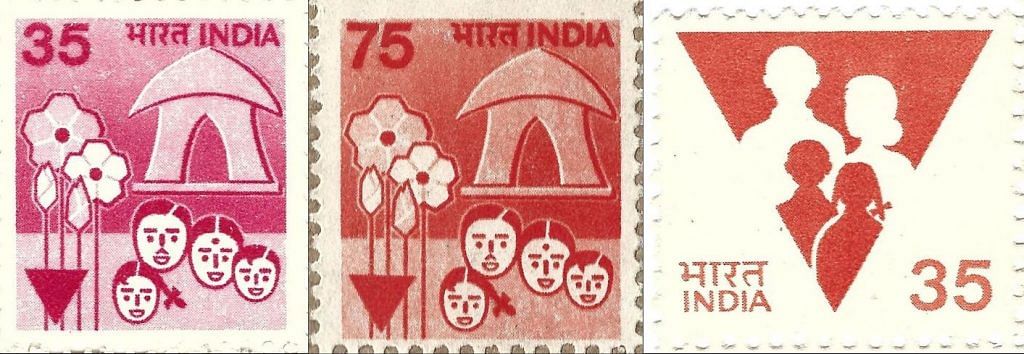
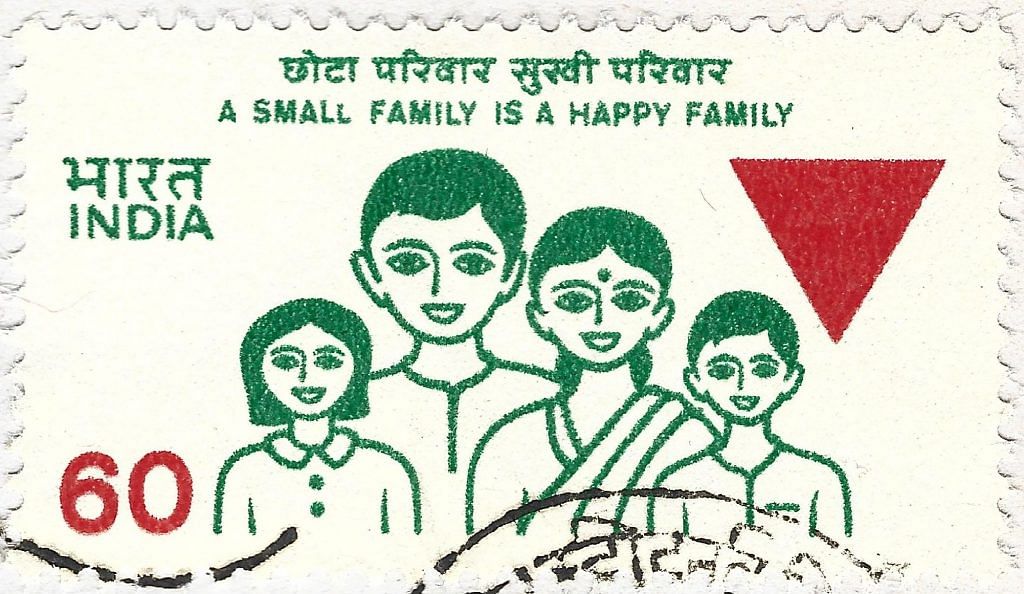
Then came the Emergency
The brochure of the 1966 stamp noted that the government planned to reduce “the country’s annual birth rate from 40 per thousand to 25, in the next 10 years.” The brochure of the World Population Year stamp (1974) shared a revised target. Instead of achieving a birth rate of 25 births per 1,000 by 1976, it suggested that the government now hoped to reach 30 births per 1,000 by 1979 – that is, by the end of the Fifth Five Year Plan. (The birth rate was 34.4 in 1976 and 33.1 in 1979, and dropped to 30 in 1990 and 25 in 2002.) The sluggish pace of fertility reduction triggered far-reaching changes in the approach to family planning and also a whole range of federal policies, including the redistribution of federal funds and parliamentary seats linked to population shares.
The most expansive philatelic statement of the government’s family planning policy appeared in the brochure Family Planning stamp (Image 8) issued in 1976 after the launch of the 20-point programme and the Constitution (Forty-Second) Amendment Act, 1976 that added “Population control and family planning” to the Concurrent List of the Seventh Schedule.
The 1976 stamp depicts the theme ‘Small Family, Happy Family’. It shows a couple with two children—a boy and a girl—and the inverted triangle symbol of family planning. The cachet of the FDC shows two flowers and two buds representing a small family and an inverted triangle. The brochure of this stamp outlined the history of family planning in India, which was divided into four phases: Clinic-based approach (First and Second Five Year Plans), community-based approach (Third Plan), involvement of “non-official organisations” (Fourth Plan), and minimum needs approach (Fifth Plan). It also discussed at length the massive administrative machinery including the Central Family Planning Council that was going to be mobilised for implementing the National Population Policy, which was “a vital component of the total strategy of socio-economic growth.” Interestingly, the brochure continues to stress the voluntary nature of the family planning programme. It is also noteworthy that after the end of the Emergency, subsequent definitive stamps on family planning were rechristened as family welfare stamps.
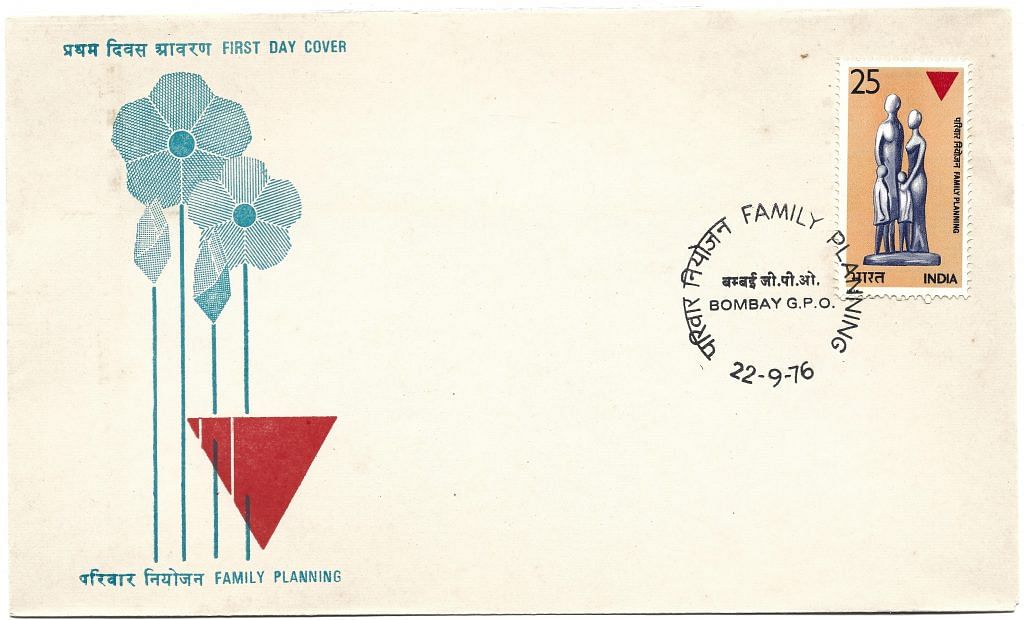
Also read: India@75 is a patchy story. But it has 25 years to fix things and make it an Indian century
The red triangle fades out
The last time family planning featured in a definitive series was in the mid-1990s when the eighth series was issued. The two stamps on family planning in this series not only did not include the familiar inverted vermillion triangle, but also showed a family of three with only one girl child. The images on these stamps carried a bilingual caption: ‘Small family, Happy family/छोटा परिवार खुशियाँ अपार (75p) & छोटा परिवार, सुख का आधार (100p)’. One of these stamps showed the parents seeing off their girlchild on her way to school with a book in her hand and a house in the background (Image 9). The shift from two children to one, in fact, happened in the stamp on the International Year of Shelter for Homeless (1987).
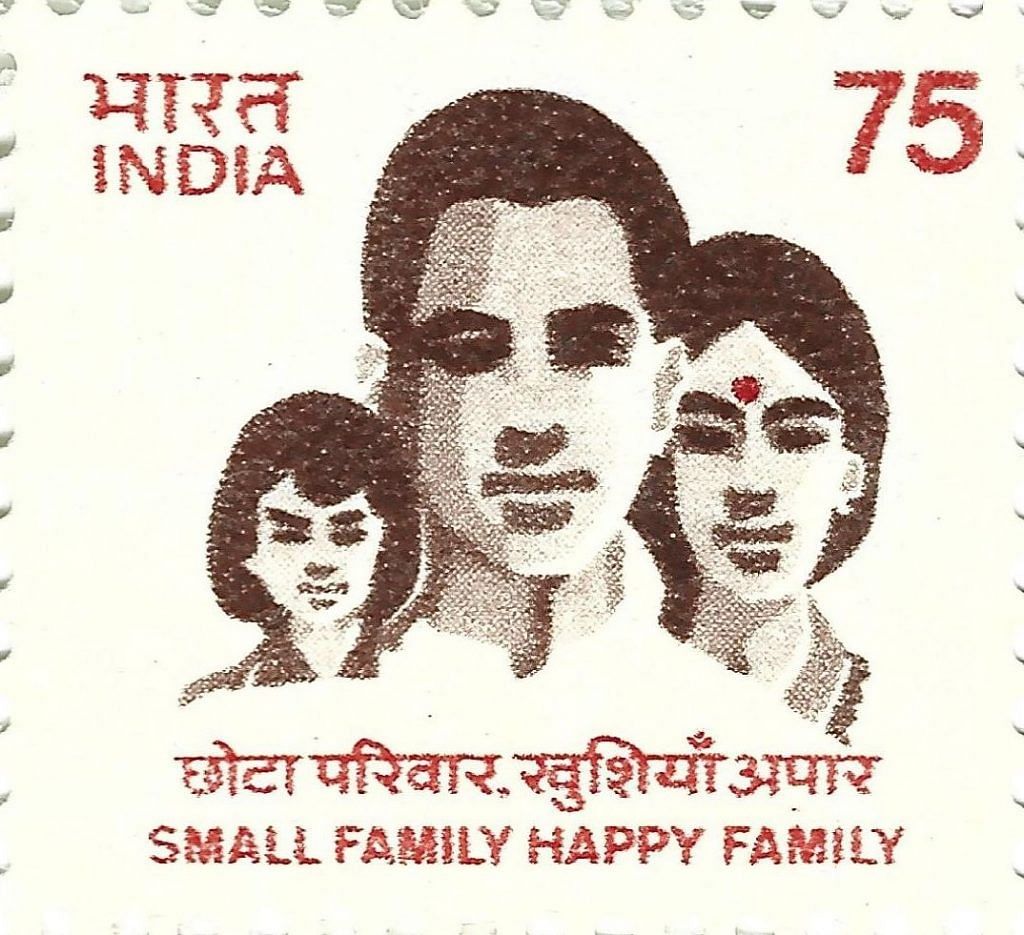
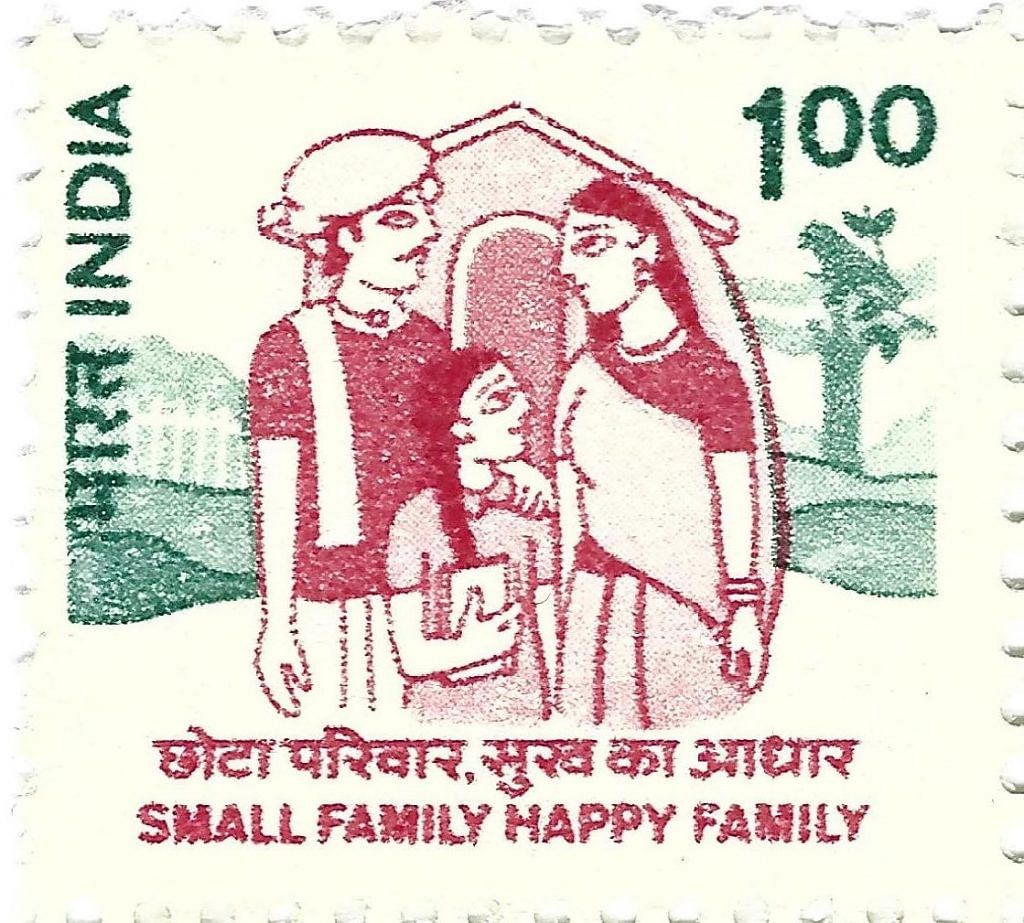
After the mid-1990s, stamps and FDCs feature families of three, including a girl. The stamp on Family the Planning Association of India (FPAI) in 1999 and Children’s Day in 2013 are cases in point. Interestingly, the postmark for the first day of issue of the FPAI stamp depicted a family of four and one of its captions was ‘Small Family by Choice’ (Image 10). The exceptions that still showed a family with two children include the stamps on the International Year of the Family (1994) and Postal Life Insurance (2009).
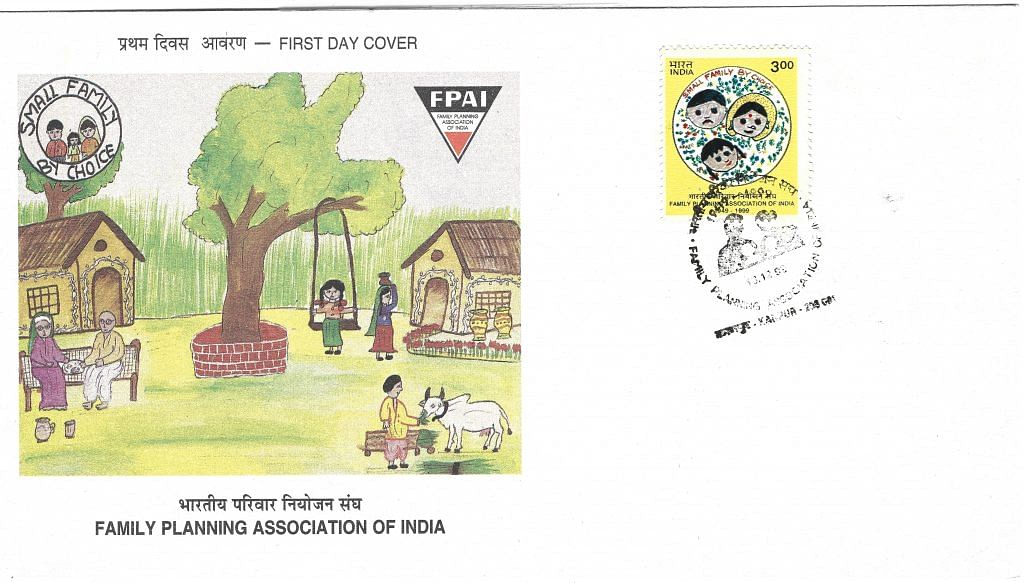
Family planning, a postal story
Family planning was a major philatelic theme for more than three decades between 1966 and 1999, and was one area where government agenda was consistent and sustained over a long period apart from being very innovative. (We have not discussed the far richer world of slogan postmarks and printed advertisements on postal stationery.) But this theme understandably faded away after India belatedly reached the target of 25 births per 1,000 around 2002 – 26 years after the initial deadline for this target.
The last stamp that referred to family planning was a commemorative issue called Newborn Health in India 2005. It bears reminding that the most coercive phase of State-sponsored family planning programme in the mid-1970s at best managed to achieve a very small decline in fertility. Any attempt to revive a coercive programme is much less likely to work in 2022, and is even otherwise superfluous as the fertility levels are in any case steadily declining.
Vikas Kumar teaches economics at Azim Premji University and is author of ‘Waiting for a Christmas Gift and Other Essays’ (forthcoming) and co-author of ‘Numbers in India’s Periphery: The Political Economy of Government Statistics’ (Cambridge University Press, 2020). Views are personal.


